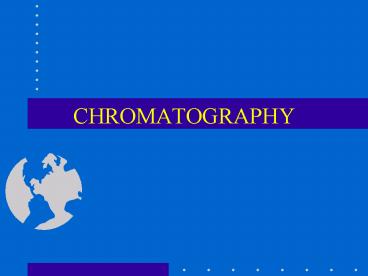CHROMATOGRAPHY - PowerPoint PPT Presentation
1 / 34
Title:
CHROMATOGRAPHY
Description:
Different affinity of these 2 components to stationary phase ... Use gradient elution. LC Application in Food System. Carbohydrates. Amino acids, proteins ... – PowerPoint PPT presentation
Number of Views:338
Avg rating:3.0/5.0
Title: CHROMATOGRAPHY
1
CHROMATOGRAPHY
2
Chromatography
Chromatography basically involves the
separation of mixtures due to differences in
the distribution coefficient of sample
components between 2 different phases. One
of these phases is a mobile phase and the other
is a stationary phase.
3
Distribution Coefficient
Definition Different affinity of these 2
components to stationary phase causes the
separation.
Concentration of component A in stationary phase
Concentration of component A in mobile phase
4
Kinds of Chromatography
1. Liquid Column Chromatography 2. Gas Liquid
Chromatography
5
Liquid Column Chromatography
A sample mixture is passed through a column
packed with solid particles which may or may not
be coated with another liquid. With the proper
solvents, packing conditions, some components in
the sample will travel the column more slowly
than others resulting in the desired separation.
6
Diagram of Simple Liquid Column Chromatography
7
Four Basic Liquid Chromatography
Basic liquid chromatography modes are named
according to the mechanism involved 1. Liquid/S
olid Chromatography (adsorption
chromatography) A. Normal Phase LSC B. Reverse
Phase LSC 2. Liquid/Liquid Chromatography
(partition chromatography) A. Normal Phase
LLC B. Reverse Phase LLC 3. Ion Exchange
Chromatography 4. Gel Permeation Chromatography
(exclusion chromatography)
8
Liquid Solid Chromatography
Normal phase LS
Reverse phase LS
d- d
Si - O - H
30 m
Silica Gel
The separation mechanism in LSC is based on the
competition of the components of the mixture
sample for the active sites on an absorbent such
as Silica Gel.
9
Liquid Solid Chromatography
OH
HEXANE
Si - OH
OH
OH
CH
CH
3
3
C-CH
CH
- C
3
3
CH
CH
3
3
CH
3
10
Water-Soluble Vitamins
11
Water-Soluble Vitamins
12
Liquid-Liquid Chromatography
ODPN (oxydipropionylnitrile)
Normal Phase LLC
Reverse Phase LLC
The stationary solid surface is coated with a 2nd
liquid (the Stationary Phase) which is immiscible
in the solvent (Mobile) phase. Partitioning of
the sample between 2 phases delays or retains
some components more than others to effect
separation.
13
Types of Chromatography
LIQUID
MOBILE PHASE
Liquid-Solid
Liquid-Liquid
Chromatography
(Adsorption)
FORMAT
Chromatography
(Partition)
Solid
Liquid
STATIONARY
PHASE
Reverse Phase
Normal Phase
Normal Phase
Reverse Phase
Mobile Phase -
Nonpolar
Mobile Phase -
Polar
Stationary phase -
Polar
Stationary phase -
Nonpolar
14
Ion-Exchange Chromatography
Separation in Ion-exchange Chromatography is
based on the competition of different ionic
compounds of the sample for the active sites on
the ion-exchange resin (column-packing).
15
Mechanism of Ion-Exchange Chromatography of Amino
Acids
pH2
-
SO
Na
H
N
3
3
COOH
Ion-exchange Resin
-
H
N
SO
3
3
-
COO
pH4.5
Na
16
Chromatography of Amino Acids
17
Gel-Permeation Chromatography
Gel-Permeation Chromatography is a mechanical
sorting of molecules based on the size of the
molecules in solution. Small molecules are able
to permeate more pores and are, therefore,
retained longer than large molecules.
18
Solvents
- Polar Solvents
- Water gt Methanol gt Acetonitrile gt Ethanol gt
Oxydipropionitrile - Non-polar Solvents
- N-Decane gt N-Hexane gt N-Pentane gt Cyclohexane
19
Selecting an Operation Mode
Sample Type LC Mode Positional
isomers LSC or LLC Moderate Polarity
Molecules LSC or LLC Compounds with
Similar Functionality LSC or LLC Ionizable
Species IEC Compounds with Differing
Solubility LLC Mixture of Varying Sized
Molecules GCC
20
Schematic Diagram of Liquid Chromatography
21
Detector
- 1. Ultraviolet Detector 200-400nm 254
nm2. Reflective Index Detector Universal
Detector
22
High Performance Liquid Chromatography
23
High Performance Liquid Chromatography
24
Retention Time Time required for the sample to
travel from the injection port through the column
to the detector.
25
Selectivity
Ratio of Net Retention Time of 2
components. (Distribution Coefficient)
26
Selectivity
- Selectivity
27
Resolution Equation
28
Resolution
29
Height Equivalent to a Theoretical Plate
Length of a column necessary for the attainment
of compound distribution equilibrium
measure the efficiency of the column.
30
Importance of Theoretical Plates (N)
31
Theoretical Plate, Selectivity and Height
Equivalent to a Theoretical Plate
V0 1.0 (Minutes) V1 5.0, V2 7.0, V3 11.0,
V4 13.0 W1 1.0, W2 1.0, W3 1.0, W4 1.0
32
Chromatogram of Orange Juice Compounds
33
General Factors Increasing Resolution
- Increase column length
- Decrease column diameter
- Decrease flow-rate
- Pack column uniformly
- Use uniform stationary phase (packing material)
- Decrease sample size
- Select proper stationary phase
- Select proper mobile phase
- Use proper pressure
- Use gradient elution
34
LC Application in Food System
Carbohydrates Amino acids, proteins Vitamins, A,
D, E, K Nucleosides (purines and
pyrimidines) Fatty acids, fats Aflatoxins Antioxid
ants Contaminants of packaging materials Carotenoi
ds, chlorophylls Saccharines

